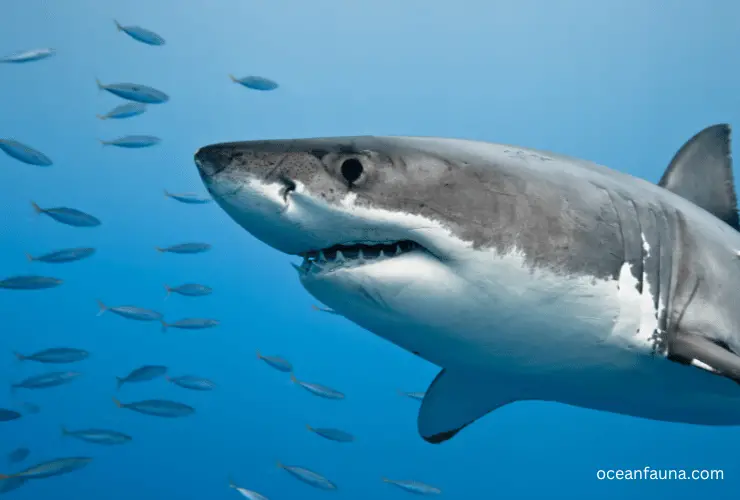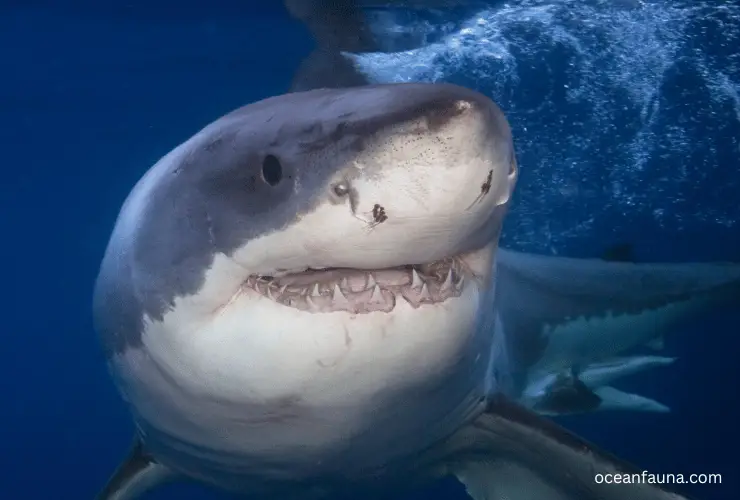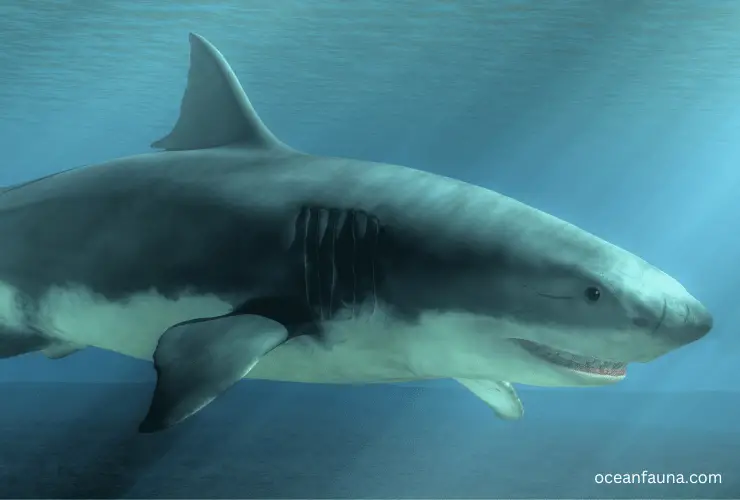Having discussed with experienced marine adventurers and thoroughly researched the topic, I am excited to share an in-depth overview of a life cycle of a great white shark.
A Life Cycle of a Great White Shark
Birth
Great white sharks give birth to live young. The gestation period is approximately 12 months, and the average litter size ranges from two to 10 pups. The mother shark gives birth in shallow coastal waters, typically around areas where there is plenty of fish for the pups to eat.
Nursery Phase
After birth, Great White Shark pups measure about 5 feet in length and weigh up to 100 lbs. During this time, they feed on smaller fish and invertebrates found in the shallow water until they reach a size of 10-12 feet (about 3 meters), which happens over a period of time ranging from 2-4 years.
Once they have achieved this size, the juvenile sharks migrate away from the nursery area into deeper waters where larger prey items can be found.
Juvenile Stage
A significant growth spurt marks the juvenile stage as the shark transitions from feeding in shallow nurseries to hunting large prey items such as seals, sea lions, and other large fish.
At this point in life, Great White Sharks also start associating with other adult sharks and become much more solitary creatures as they progress through their lifespan. It has been observed that juveniles will form social groups with other juveniles during times of plentiful food sources or when migrating between different regions.
Maturity
It is believed that great white sharks reach adulthood at around 8-10 years old when they are 15 feet (almost 4 meters) long and weigh an average of 1 tonne (1000 kgs).

At this stage, their diet changes again as they consume larger prey items such as dolphins, whales, and sea turtles, with occasional scavenging opportunities on dead animals when available.
They also start roaming greater distances over time as part of their migration patterns towards warmer waters during winter months and cooler ones during summertime periods.
Mating Season
Each year Great White Sharks migrate towards specific mating sites located across various parts of the ocean, where male sharks compete for female attention by displaying aggressive behavior such as biting one another’s tails or fins in order to establish dominance over a particular area or mate.
The female then releases her eggs while the males release sperm to fertilize them before leaving the area soon after mating season is completed each year.
Reproduction
Great White Sharks reproduce by ovoviviparity, meaning that their eggs develop inside the uterus before being born and live in shallow coastal waters, much like mentioned before in the birthing process itself, although not all pregnancies reach full term due to predation or malnutrition during development stages, so it is common for fewer than ten pups make it out alive during each mating season cycle per female shark every year on average.
Aging & Death
With limited records, it is difficult to predict just how long great white sharks live; some scientists postulate that the species can reach up to 60 years of age.
On the other hand, human-caused fishing and natural mortality rates due to diseases likely linked with aging processes may reduce their lifespans below what was initially thought—just like any other species would experience without proper health care throughout its life.
What Do Great White Sharks Eat?
Great white sharks have varied diets depending on their age. From juvenile to mature stage, great white sharks are known to feed on fish, including herring, mackerel, cod, salmon, and halibut; other bony fish; sea birds such as gulls and cormorants; smaller sharks and rays; squid and octopus; sea turtles and their eggs; crustaceans such as crabs and lobsters; marine mammals such as seals and sea lions, dolphins, porpoises, whales, manatees, dugongs, and sea otters.

Juvenile great white sharks begin feeding on small fish like anchovy or smelt when they reach 30cm-1m in length. As they grow larger, they start to eat a variety of prey items.
Juveniles can also be observed eating jellyfish. These animals provide an important source of nourishment to the young sharks as they establish themselves in the environment. In areas where these prey items are more abundant, it has been observed that great juvenile whites tend to be larger than those found in areas with lesser availability of prey.
Once the adult size is reached (4-5 meters long), the diet of great whites becomes even more diverse. They will feed upon large bony fish such as tuna and swordfish as well as small pinnipeds like seals or even large marine mammals like humpback whales or gray whales.
Great whites also feed upon carrion from dead animals, which may sometimes be quite large. It is believed that this type of scavenging allows them to spend time away from foraging for live prey, allowing them maximum energy efficiency when hunting for food.
Great white sharks are opportunistic predators meaning that if given the opportunity, they will take advantage of whatever food sources are available – whether it be small fish or large marine mammals – making them one of the most successful predators in the ocean today!
Do Great White Sharks Eat Humans?
No, great white sharks do not typically eat humans. While it is true that these creatures are among the world’s top predators and will sometimes attack humans, it is usually not done with the intention of eating them.
Great white sharks tend to feed on marine animals like sea lions, seals, fish, and even small whales, whereas attacks on humans have typically been attributed to a process known as ‘hit-and-run feeding.’ In this type of feeding behavior, the shark may take a bite out of a human to determine whether they are food.
Unlike other predatory animals that actively seek out human prey, sharks rarely target people as an intentional meal. When they do attack people in the water, it is usually because they mistook them for another marine animal – such as a seal or sea lion – due to their silhouette or behavior in the water.
This type of mistaken identity can lead to some pretty traumatic injuries on the part of the human victim but rarely leads to death by shark attack. The majority of reported shark attacks (over 90%) were cases involving “hit-and-run” feeding behaviors, and no fatalities occurred from these incidents.
In addition to this type of non-predatory behavior when it comes to humans, great white sharks also have a number of natural characteristics that help protect them from being eaten by us.
For instance, their skin contains denticles – tooth-like scales that make it difficult for us to grasp or hold onto with our bare hands.
Additionally, their mouths contain rows upon rows of sharp triangular teeth, which would make any attempt at hand fishing near impossible!
Ultimately, while we must remain wary when swimming in waters where great white sharks may be present due to their size and strength, we don’t need to worry too much about becoming dinner if one happens across our path!
How Do Great White Sharks Die?
All types of sharks, including great white sharks, succumb to a variety of causes. Here are some common ones:
Overfishing
Great white sharks are one of the top predators in the ocean, and as such, they face a concerted effort from fishermen to capture them for their valuable fins, meat, and oil. This has drastically reduced the population of great white sharks in many parts of the world due to their slow growth rate and low reproductive capabilities.

The international trade of shark fins has put tremendous pressure on this species since it can take up to 10 years for a single individual to reach maturity. In addition, illegal fishing operations often target great whites without any regard for conservation measures or regulations.
Habitat Loss
As human populations have grown over time and urban areas have expanded into coastal environs, great white shark habitat has been lost or degraded due to development projects or other human activities such as coastal dredging.
Pollution is another major factor affecting these species’ health by reducing oxygen levels in their habitats. These increasing sedimentation levels can smother bottom-dwelling creatures essential to the food chain and introduce dangerous toxic chemicals into the water column.
Incidental Catch
Despite awareness campaigns and government regulations targeting fishing practices that accidentally ensnare marine wildlife like sea turtles and dolphins, unfortunately, great white sharks are still caught in nets used for commercial fisheries around the world.
Entanglement in fishing gear can cause serious physical injury or death when these apex predators cannot reach deeper waters where oxygen levels are higher, and they can easily breathe again.
Climate Change
Rising temperatures due to climate change are causing many species to shift their ranges further north away from tropical waters (i.e., further away from areas where great whites reside).
Additionally, data shows that climate change is likely altering ocean circulation patterns which disrupt migration routes needed by some shark species, including great whites, who depend upon such migratory pathways to find new breeding grounds every season.
Finally, warmer waters reduce dissolved oxygen levels leading to decreased productivity among plankton which forms a significant portion of the diet of newly born pups who rely on these tiny creatures for sustenance until they reach adulthood when they begin preying upon larger prey items like seals or sea lions.
Disease
Just like any other animal that lives in a large group, close contact between members of the great white shark population can enable the disease to spread quickly across an entire population. To prevent this from happening, it is vital for appropriate management techniques to be implemented and enforced, such as quarantine protocols or providing medical care when needed (and possible).
Sharks may contract illnesses from other organisms brought into contact during feeding behaviors or due to changes within their environment caused by humans (pollution etc.).
Aging
Like other species, aging is a natural process that all great white sharks experience. As they age, their growth rate slows, and they become increasingly vulnerable to predation or disease due to weakened immune systems and slower reaction times when hunting for food.
Eventually, even the largest great white shark on record will succumb to old age unless it meets an untimely end from any of the other causes mentioned in this article!
Conclusion
The great white shark is a remarkable species, but unfortunately, we are still learning about the threats they face in the wild. In addition to overfishing and habitat loss, other human activities such as pollution, incidental catch, climate change, and disease all put this apex predator at risk.
By adhering to modern management practices and raising awareness of the significance of protecting aquatic wildlife for future generations, we can ensure that great white sharks remain an emblematic symbol in our seas for years to come.


4 thoughts on “Life Cycle of a Great White Shark”